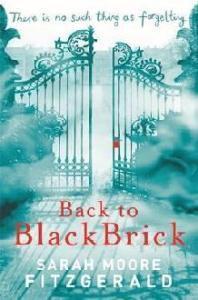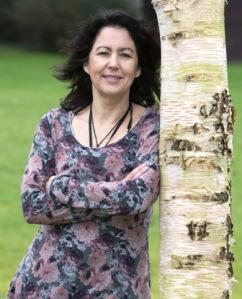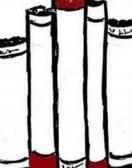As previously promised, I am today hosting a new YA author on The Landing Bookshelves. Sarah Moore Fitzgerald, a professor from Limerick University, publishes her first novel today. I was lucky enough to receive a proof copy of Back to Blackbrick before Christmas. I was immediately attracted by both the time traveling element of the story and the back drop of ‘The Big House’ where so many fascinating stories often lurk. It is clearly a fascination that many readers and writers share. The great houses of Ireland and Britain have long provided much food for thought.

This kind of setting always interests me for personal reasons, in that my late grandfather was a gardener at Grove Hall in Harborne, Birmingham (demolished in the 1970s) home of a prominent local family. The grounds are now a public park. I recently spotted a large cedar tree in a photograph of the grounds of Grove Hall; it dawned on me that it must be the same tree that I played under as a child, when the grounds had been handed over to the council. Time travel of a sort, perhaps.
I asked Sarah to talk to us about the background to her novel and about the research that underpinned the novel. Like me, Sarah admits to a fascination with the life and history of the big country house. When we chatted last week, we talked a little about this, mentioning the brilliant Abandoned Mansions series of books by Tarquin Blake (see previous post).
Here is Sarah’s piece, written especially for The Landing, in which she talks about her influences:
How a history book helped to inform and inspire my first novel
At the center of my first novel, there is a big house called Blackbrick Abbey. Two big avenues lead up to it – one from the south and one from the north. In the grounds there are stables, beautiful horses, big trees and an orchard with apple sheds and a gate lodge. Very early on in the story, Cosmo, the main character, gets a key to the gates of Blackbrick from his brilliant, lovely grandfather. But it’s only when Cosmo gets there, that he realises he’s been sent to the past in order to recover his granddad’s failing memory. The huge old house contains secrets that will help him to make sense of important things in his life.
I’ve always been kind of obsessed with the idea of ‘Big Houses’ and the complicated things they represent. I was captivated, as generations of children were, by Misselthwaite Manor in The Secret Garden and later, by the strange evocative Anglo-Irish climate of Danielstown in Elizabeth Bowen’s The Last September, by Molly Keane’s descriptions of a family keeping up appearances in the crumbling manor of her deliciously dark Time After Time and to Evelyn Waugh’s heartbreaking Brideshead Revisited. In all of these stories, the big house sits silent and gigantic at the heart – symbolizing family identities and their labyrinthine dynamics and secrets.
I probably shouldn’t have been surprised that when I started to write my own novel, a house like this would somehow become a crucial part of the story’s backdrop. When the idea for Back to Blackbrick was being formed, I remember stumbling upon the non-fiction gem by historian Terence Dooley, entitled The Decline of the Big House in Ireland. That’s when a major part of the plot crystallized in my head, and I decided that my character was going to have to spend some time in the past. Writers often warn that too much research can distract novelists from getting on with the story – that if you get too immersed in the history of an era you disappear into the research, abandoning the novel. But when I read Dooley’s book, replete as it is with wonderful and impeccably researched historical descriptions, the opposite happened – it spurred the creative writing side of my brain with the curiosity to explore hints of a human story that could lie behind the historical facts.
While Back to Blackbrick is set in both the present and the past, and while I have tried to paint the historical references with a light touch, Terence Dooley’s book gave me a rich sense of themes that eventually became a really important part of the story – reminding me never to underestimate the power of historical non-fiction to provide luminous raw material for storytelling.

Sarah Moore Fitzgerald
Sarah Moore Fitzgerald is a professor at the University of Limerick. Late at night, she writes stories for her children. Her first novel, Back to Blackbrick (Orion Children’s Books) is out on Feb 7th.
With many thanks to Sarah for joining me as a guest on The Landing and lots of luck with Back to Blackbrick. If you would like more infromation take a look at Sarah’s agent’s website here.
Photo credit: Liam Burke/Press 22

